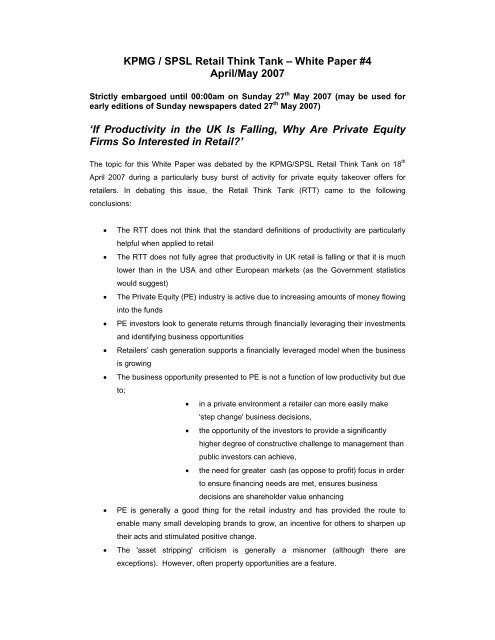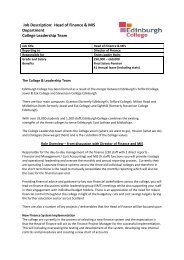KPMG / SPSL Retail Think Tank – White Paper #4 April/May ... - Hays
KPMG / SPSL Retail Think Tank – White Paper #4 April/May ... - Hays
KPMG / SPSL Retail Think Tank – White Paper #4 April/May ... - Hays
You also want an ePaper? Increase the reach of your titles
YUMPU automatically turns print PDFs into web optimized ePapers that Google loves.
<strong>KPMG</strong> / <strong>SPSL</strong> <strong>Retail</strong> <strong>Think</strong> <strong>Tank</strong> <strong>–</strong> <strong>White</strong> <strong>Paper</strong> <strong>#4</strong><strong>April</strong>/<strong>May</strong> 2007Strictly embargoed until 00:00am on Sunday 27 th <strong>May</strong> 2007 (may be used forearly editions of Sunday newspapers dated 27 th <strong>May</strong> 2007)‘If Productivity in the UK Is Falling, Why Are Private EquityFirms So Interested in <strong>Retail</strong>?’The topic for this <strong>White</strong> <strong>Paper</strong> was debated by the <strong>KPMG</strong>/<strong>SPSL</strong> <strong>Retail</strong> <strong>Think</strong> <strong>Tank</strong> on 18 th<strong>April</strong> 2007 during a particularly busy burst of activity for private equity takeover offers forretailers. In debating this issue, the <strong>Retail</strong> <strong>Think</strong> <strong>Tank</strong> (RTT) came to the followingconclusions:• The RTT does not think that the standard definitions of productivity are particularlyhelpful when applied to retail• The RTT does not fully agree that productivity in UK retail is falling or that it is muchlower than in the USA and other European markets (as the Government statisticswould suggest)• The Private Equity (PE) industry is active due to increasing amounts of money flowinginto the funds• PE investors look to generate returns through financially leveraging their investmentsand identifying business opportunities• <strong>Retail</strong>ers’ cash generation supports a financially leveraged model when the businessis growing• The business opportunity presented to PE is not a function of low productivity but dueto;• in a private environment a retailer can more easily make'step change' business decisions,• the opportunity of the investors to provide a significantlyhigher degree of constructive challenge to management thanpublic investors can achieve,• the need for greater cash (as oppose to profit) focus in orderto ensure financing needs are met, ensures businessdecisions are shareholder value enhancing• PE is generally a good thing for the retail industry and has provided the route toenable many small developing brands to grow, an incentive for others to sharpen uptheir acts and stimulated positive change.• The 'asset stripping' criticism is generally a misnomer (although there areexceptions). However, often property opportunities are a feature.
IntroductionThe poor productivity performance of the European Union and the UK is something thatcontinues to hit the headlines. According to AIM, a national research programme co-fundedby the ESRC (Economic and Social Research Council) and the EPSRC (Engineering andPhysical Sciences Research Council), productivity in the UK’s business sector in 2001 wasmore than 40% lower than in the US. Statistics published by the University of Groningen in2005 reported that while productivity growth in the US accelerated from 1.3% during theperiod 1980-1995 to 1.9% during the period 1995-2003, in the European Union it declinedfrom 2.3% to 1.3% over the same time frames. The business sector held to be mostresponsible for the growing productivity gap between the US and the UK is wholesale andretail, accounting for 19% of the gap in 2001, up from 11% in 1990.So it seems that the UK retail sector, responsible for 6% of the nation’s GDP and 11% of theworkforce, is a principal contributor to Britain’s low productivity and a growth rate laggingbehind the G7 and many other OECD countries.But is this a fair accusation? Is it a reason why PE groups have shown a voracious appetitefor retail companies in the UK in recent years? This is the topic that the RTT set out to debatein its most recent sitting in <strong>April</strong> 2007.The RTT argues that the low productivity attributed to the UK retail sector largely hangs onthe way that productivity is defined. Policymakers and economists, including the Treasury,use labour alone as the key leitmotif of productivity. And on this basis, the RTT accepts thatthere is some evidence that labour productivity in UK retailing is lower than in some othercountries. But it points out that cross-nation comparisons of labour productivity are fraughtwith difficulty. For example, in the UK the composition of retail employment is very differentfrom that in the likes of the USA and France, where far fewer part-time workers are employed.The way that labour inputs are conventionally calculated in productivity measures alsodisadvantages the UK compared to many other countries.Members of the RTT felt that productivity in the retailing sector really ought to be viewed in abroader context. “In my opinion” commented Prof. John Dawson, Universities of Edinburghand Stirling, “productivity increase is simply getting more out of an asset for the same input,such as a labour cost but certainly other costs too.” So the RTT in its discussions favoured amore inclusive definition of productivity. In its view the restriction of using labour as the onlyinput that is generally considered in an economic perspective of productivity, is too narrow adefinition and casts the UK in a bad light, which is both unwarranted and not useful.2
accurate and timely data, particularly at a national level. Anyone with any experience of tryingto collect labour statistics (for example) from a retailer will readily understand this. Adding thecross-country differences in data collection methods and definitions make like-for-likecomparisons even more difficult and thereby less meaningful.Much of the debate about productivity centres on the input side. Output is measured either ingross output or gross margin terms, but were one to view it as “value added” in its broadestsense then the calculation becomes even more difficult to do. The RTT argues that were thisto be done, then the UK’s productivity performance would improve substantially.For all these reasons, the RTT considers that it is inappropriate to view productivity in theretail sector in the UK to be as low as it is often reported. Furthermore, the RTT isunconvinced that the productivity gap against other nations is increasing. The panelconcluded that because the real numbers are masked by property and occupational costs andplanning restraints productivity often looks worse than it otherwise would.The RTT also rebuffs the notion, current in some quarters that any sense of poor productivityin the sector is the consequence of ineffective and poor quality management, low labourproductivity, lack of general competitiveness and the slow adoption of ICT (InformationCommunication Technology).If this were true, overseas players would have come in and rapidly succeeded here, andgenerally they haven’t. For instance there are few examples where retailers are bringing inswathes of senior managers from overseas to replace UK counterparts. Instead the evidenceis that UK-sourced management is now venturing abroad and not only for expansionist UKstore chains such as Tesco but also for far smaller players such as Royal stationer Smythson.So just why are PE firms so interested in <strong>Retail</strong>?Tim Denison of <strong>SPSL</strong> commented that; “put most simply, the assessment criterion is whetherthe deal will deliver returns substantially above other mainstream asset classes i.e. equitiesand bonds.” The first reason for the interest, the Members all agreed, is because retail is acash generative business. Goods are often sold before they are paid for and strong cash flowallows fast amortisation of debt and when coupled with rationalisation of assets can mean aspeedy return for investors.As Richard Hyman of Verdict Research succinctly explained; “In these days of progressivelyextending payment periods, a growing number of retail businesses are able to sell their stockbefore they pay for it. Most of these deals depend one way or another on borrowing largesums to do the deal and then using cash from the leaner, fitter acquired business to pay back4
the debt. The acquired company in effect pays for itself to be taken over. <strong>Retail</strong>ers are betterplaced than most to facilitate this because they are so cash rich.”PE houses look to capitalise on this fundamental strength of the retail sector by selecting theirtargets on the principal basis of two simple criteria. These are:-• the capacity demand for further significant rollout (estate expansion)• the potential for enhancements and extensions based on the strength of the brandCommenting on this, Paul Clarke of Barclays <strong>Retail</strong> & Wholesale Sectors explained; “<strong>Retail</strong> is‘instant’ compared to other businesses. It can happen very quickly. You can open new units,put on more sales, the growth opportunities are very good. The payback from capitalinvestment in a new store can be within 18 months which compared to other industries is veryquick.”Interestingly RTT Members did not agree unanimously that PE groups include a strongmanagement team as a third criterion, quoting recent examples of retailers whose seniorteams had been swiftly dismantled and replaced.Secondly, the current level of interest is fuelled by the large amounts of funds available attheir disposal and currently there to be invested. The ready supply of cash is driving demandfor deals. Thirdly, building upon this, retail deals have had a great track record for theinvestor; there have been some spectacular successes, take Debenhams as a recent case inpoint. There are great potential opportunities to be had through very straightforward financialengineering.A very strong motivator towards retail for PE groups can be a property portfolio of the targetretailer. Its value is a big attraction, and cash flows from it are predictable. A PE firm acquiringa property rich company will almost certainly have as its number one priority to separate noncorefrom core business elements. Freehold property is just such a tempting element. Armedwith a property portfolio it’s a simple matter to sell the estate to the highest bidder and leaseback the premises or to establish an OpCo/PropCo structure with greater borrowing capacityin the PropCo.The target retailer itself thus provides huge sums of money to pay off some of the acquisitioncosts making it a very attractive target. Admittedly it does, by doing so, become freer toconcentrate on its core activities. The downside is that it is saddled with ongoing rental feeswhich will have been negotiated at the time of the purchase and which, depending on therequirements of the PE firm for cash at the time of negotiation, may not be the mostfavourable possible.5
The final reason for the private equity interest identified by RTT Members is the very fact thatretailers are numerous, high profile, excitingly ‘rich’ targets and can be readily assessed bynot only looking at their published results but also by simply walking down any high street.So is PE’s attraction to retail a function of the potential to behad in productivity gains?The RTT believes not in strict sense of labour-based productivity, but certainly once they havesuccessfully identified, targeted and acquired a retailer, PE firms look to change threeelements of that business as soon as possible. Helen Dickinson of <strong>KPMG</strong> calls this “sweatingthe assets”.Element “Number One” relates to changing the financial structures, for example, thecompany’s leverage. A lot of what PE houses do impacts cash flow much more thanprofitability because after the cash flow becomes more generative, they can decrease theleverage. They’re less concerned by margin, therefore, than in keeping the mill turning. Inother words, in the private arena, the focus is on cash flow whereas in the public market thereis far greater attention given to profit.Publicly quoted retailers have other concerns too. For instance, if a management teamdisposes of some assets, say by selling freeholds and concluding lease-back deals, theinstant cash-flow boost will look good on the books for one quarter or one half-year but maymake future trading look very lacklustre, opening up management to criticism. PE firms haveno such qualms. If they decide to get instant results, a broad based programme of disposal,rationalisation, improvement and optimisation is exactly what they will do from day one. Withno public shareholders, as such, they are well placed to do it. As Helen Dickinson noted; “It’sthe difference between profits and cash. It’s that simple. There is far more focus on short termprofit in the public arena. Far more on cash flow in the private.”Vicky Redwood of Capital Economics agreed: “Like for likes are more important than cashflow in the public arena. In the private equity context there are no quarterly like for likes toanalyse and sweat over; just cash and the growth potential. VC houses don’t generallyinterfere in management in one sense, but in another sense are even more challenging thanthe City.”Element “Number Two” takes up that point and centres on management excellence and itsability to improve the business’s efficiencies. Paul Clarke noted that “PE houses interested inretail know a lot about each company even before they attempt a takeover. They analyse thecompany at least ten times more than the company’s own management team, so will often6
know more about the company that its own management. That’s not a bad thing and certainlyhelps them guide the management when they acquire it.”The new owners will quickly seek to deconstruct and reconfigure every element that can besubjected to efficiency improvements, from sourcing through to marketing, staffing through tosuppliers. Under PE control retailers will certainly put pressure on suppliers. If suppliers arecurrently paid 30 days in arrears, the new owners will demand 60; if 60 they’ll demand 90.“The Baugur model is particularly interesting”, commented Tim Denison. “It looks to make asignificant rationalisation in the cost arena by building and sharing a back end, ‘big box’solution amongst its retailers, which spans their back office IT platform, e-commerceoperations and HR functions.”Admittedly many of these are things that quoted companies can do too, but their managerstend to be more cautious, more risk averse. Store management teams answering to the Cityand market investors more often than not believe that the short term perspective taken by themarket constrains them from taking anything but iterative management decisions. There islittle doubt that the market drives the current management of publicly quoted companies and itthus often may not be in a position to take the actions to accelerate the performance stepchanges that a PE house can and will.However, Paul Clarke pointed out that Stuart Rose, a man who has successfully resurrectedone trader’s profitability while it’s still a quoted company is neither averse to demanding moreof suppliers, nor making bold step-change decisions; “This is not just any chief exec, this isthe M&S chief exec”, he noted. Nick Bubb of Pali International agreed that the managementconstraints on public companies should not be overplayed; “Tesco, although not a PEacquiredfirm, has shown how well it is able to constantly improve the efficiency of retailingand never seems to question how far efficiency gains can be made.”Vicky Redwood speculated that PE firms might, by their very presence, encourage publicretailers to up their game, leveraging-up to put off PE takeovers and thus consciouslyremoving some of their nascent tax advantages. Nick Bubb agreed, citing Topps Tiles whichis now, he said; “highly geared in order to see off predators - and this in a market where grossmargins are on average a whopping 62%.”Element “Number Three” involves focusing on establishing the seed bed to foster valueadded output <strong>–</strong> the means to accelerate the delivery of sales growth, as a businessimperative. Invariably this involves investment, whether it is to roll out a store chain nationally,build a brand’s profile, or extend the reach in other ways such as on-line, licensing, spin-offs,new lines etc.7
So, in the final analysis, is PE good or bad for retail?This is a question which our panel took some time to answer and of course the answer canvary retailer to retailer, deal by deal. Good outcomes are certainly not rare. For instance, adeal such as Hobbs where the PE firm takes a somewhat longer term view and expands abusiness’s profitability is generally seen as good by the RTT. In such deals everyone it seemsis a winner; the PE house pays a premium so the shareholders are happy. The business isboosted by disposals, rationalisation, improvement and optimisation, so the staff andcustomers are generally happy, and even suppliers, though often squeezed on margin, canbe delighted by increased orders.Other PE deals are somewhat less satisfactory. Our panel concluded that many of thesedeals are led by large, generalist firms, often from the USA, some of whom do not fullyunderstand the very real differences in trading conditions in the UK. Rent and occupationalcosts as well as complex and difficult planning restrictions leave many retailers locked intoinappropriate and non-optimal aged properties with too little space and/or the wrong space.So there is scope for investors to be misguided in seeing an opportunity to introduce someswift ‘productivity increases’ and ‘asset stripping’, when in fact the results may not alwaysmatch the expectations.However, for all that, they can still do much that strengthens UK retail for all. PE houses willalways be more challenging and closer to management and it is a universal truth that anindependent oversight can put some real muscle into management. The challenge to themanagement of the business that they pose can thus serve the company and, throughcompetitive pressures, the industry well. PE houses bring a different retail focus which canincrease the ability of the retailer to take dramatic actions. Thus PE deals can literally andalmost magically transform a retailer’s results.The RTT concluded that PE firms get a bad name because of so-called asset stripping andyet many have looked to build the long-term success of their acquisitions; New Look andHobbs being two examples of more positive stories. The RTT also noted that despite thegrowing media coverage of PE companies’ frenzied interest in retailers such as AllianceBoots, Sainsbury, B&Q and Next, the number of actual PE deals (large deals involving largeretailers) has actually declined over time.Paul Clarke noted that “There are fewer large PE takeovers in retail than even two years ago.Look at the statistics. Sure, the numbers are going up but there have only been six dealsworth more than £50 million in 2006 and just five between £20 million and £50 million.” Nick8
Bubb added that “lots of deals get talked about, few are concluded. Look at Woolworth’s,HMV, Kesa and Sainsbury.”ConclusionThe RTT deliberations have thrown up some interesting aspects of the PE takeoverphenomenon. The RTT strongly disagrees with the Government’s position on productivityfailings in British retail and has concluded that while there is always room for improvementBritish retail is not competing on a level playing field with its cousins in Europe and the USAand therefore it is not reasonable to make such comparisons.The RTT also looked at why productivity in retailing in the UK appears to be falling. Itconcluded that using labour as the only input was too narrow a definition and distorted theoutputs. The RTT concurred that the retail sector here may not actually be as productive as insome other parts of the world but that this should not reflect badly on UK retailers. It believesmuch of the explanation results from the composition of the workforce and planningregulations, neither of which are within the hands of retailers to control.Looking at the effects of PE takeovers on retail the RTT decided that some British companieshave benefited significantly by being taken over, going from strength to strength, others lessso. Yet other retailers, finding themselves as possible targets, have been forced to up-theirgameas a result of the threat they bring. PE companies with extremely short term plans orones based on overseas business models, it was felt, did not do well. Those who wereprepared to ‘sweat the assets’ did much better.When considering why PE firms are so interested in retail our panel decided that being a cashgenerative business came first, closely followed by the opportunity to leverage assets such asfreehold property and some way after that opportunities to extend the brand and instigaterationalisations. Whether PE firms ignore the longer term potential of retail businesses, islargely an issue of perception. Yes, ‘asset stripping’ takes place but one firm’s asset strippingis simply another’s rationalisation.So is PE good or bad? Our panel decided that on balance the flurry of takeover attempts onBritish retailers was a good thing, driving improvements throughout the industry. Ultimatelythe strongest and fittest retailers are those that will survive, be they takeover ‘victim’ orsuccessful public company seeing off a bid.ends9
Note to Editors: First mentions of the <strong>Retail</strong> <strong>Think</strong> <strong>Tank</strong> should be as follows: the<strong>KPMG</strong>/<strong>SPSL</strong> <strong>Retail</strong> <strong>Think</strong> <strong>Tank</strong>. The abbreviations <strong>Retail</strong> <strong>Think</strong> <strong>Tank</strong> and RTT areacceptable thereafter.The RTT was founded by <strong>KPMG</strong> and <strong>SPSL</strong> in February 2006. It now meets quarterly toprovide authoritative ‘thought leadership’ on matters affecting the retail industry. All outputsare consensual and arrived at by simple majority vote and moderated discussion. Quotes areindividually credited.The <strong>Retail</strong> <strong>Think</strong> <strong>Tank</strong> has been created because it is widely accepted that there are so manymixed messages from different data sources that it is difficult to establish with any certaintythe true health and status of the sector. The aim of the RTT is to provide the authoritative,credible and most trusted window on what is really happening in retail and to develop thoughtleadership on the key areas influencing the future of retailing in the UK.Its executive members have been rigorously selected from non-aligned disciplines to highlightissues, propose solutions, learn from the past, signpost the road ahead and put retail into itsrightful context within the British social/economic matrix.Members are:Nick Bubb, Pali InternationalPaul Clarke, Barclays <strong>Retail</strong> & Wholesale SectorsSian Davies, Henley Centre HeadlightVisionProf. John Dawson, Universities of Edinburgh and StirlingDr. Tim Denison, <strong>SPSL</strong>Helen Dickinson, <strong>KPMG</strong>Richard Hyman, Verdict ConsultingVicky Redwood, Capital EconomicsMark Teale, CB Richard EllisThe RTT is free of any political, commercial or financial bias. It does not seek to besensationalist, nor is it afraid to speak its collective mind. The RTT does not aim to rufflefeathers but it will not flinch from expressing its democratically-arrived-at opinion.The intellectual property within the RTT is jointly owned by <strong>KPMG</strong> (www.kpmg.co.uk) and<strong>SPSL</strong> (www.customercounting.com).For media enquiries please contact:Theo Chalmers, Managing Director, Verve Public RelationsTel: 01908 275271 or 07932 004632E-mail:t.chalmers@vervepr.co.uk10
















